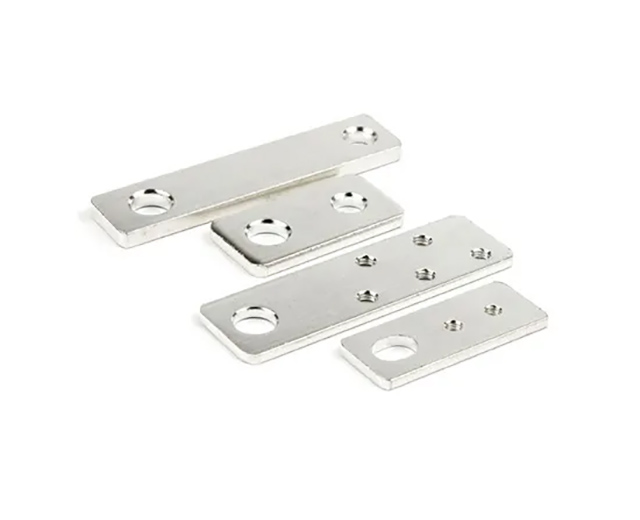2025-07-03 17:45:55
A tin plated copper bus bar is an essential electrical component that serves as a conductor for distributing power within electrical systems. It consists of a high-purity copper core (minimum 99.9% Cu) with a thin layer of tin plating (typically 2-20μm thick) applied to its surface. This combination leverages the excellent conductivity of copper while benefiting from the protective properties of tin.
The tin plating process is typically performed through electroplating or hot-dipping methods, with electroplating being more common for precise thickness control. The plating must achieve 100% coverage with no porosity to ensure complete protection against corrosion.

Tin plated Copper Bus Bars offer several distinct advantages:
Electrical Conductivity: Maintains 85-100% IACS (International Annealed Copper Standard) conductivity, with typical values of 58×10⁶ S/m at 20°C. The tin plating adds minimal resistance (~11.6% IACS) due to its thinness.
Corrosion Resistance: The tin layer provides excellent protection against oxidation, with salt spray test results showing 500+ hours to white corrosion and 1000+ hours to red corrosion per ASTM B117 standards.
Temperature Performance: Operates effectively in a range of -40°C to 105°C continuously, with short-term peaks up to 150°C possible. The melting point of tin plating (232°C) is lower than copper (1085°C), which affects high-temperature applications.
Mechanical Properties: Tensile strength ranges from 200-400 MPa depending on copper temper, with elongation of 15-40%. The tin plating adds 5-10% to surface hardness (Vickers hardness 120-150 HV for tin vs 40-100 HV for copper).
Contact Resistance: Maintains low contact resistance of 5-50 μΩ at interfaces, compared to 1-10 μΩ for bare copper. The tin layer prevents copper oxide formation which could increase resistance to 1000+ μΩ.
Solderability: Excellent solder wetting characteristics with wetting times of 1-3 seconds using standard SnPb or SAC alloys, compared to 5-15 seconds for bare copper that requires flux.
Tin plated Copper Bus Bars find extensive use across various industries:
Power Distribution Systems: Used in switchgear, panel boards, and breaker boxes where 100-5000A current carrying capacity is required. Typical sizes range from 3mm × 25mm to 12mm × 100mm cross-sections.
Telecommunications: Employed in central office power plants and backup systems due to their stable contact resistance over time, critical for maintaining signal integrity in 48V DC systems.
Transportation: Essential in rail and electric vehicle power systems where vibration resistance (up to 5-15G acceleration) and corrosion protection from road salts are crucial.
Renewable Energy: Widely used in solar combiner boxes and wind turbine converters, where they must withstand 20-30 year service life in outdoor environments with 85% RH humidity.
Industrial Machinery: Applied in motor control centers (MCCs) and variable frequency drives (VFDs) where 600V AC systems require reliable, low-impedance connections.
Data Centers: Critical for busway systems in server farms, where 99.999% uptime requirements demand corrosion-free connections even in 40-55°C ambient temperatures.
Proper maintenance ensures optimal performance and longevity:
Visual Inspection: Quarterly checks for tin discoloration (which appears as yellowing or gray spots) indicating oxidation. Any area with >30% surface discoloration should be addressed.
Contact Resistance Testing: Annual measurement using micro-ohmmeter should show <50 μΩ at joints. Values exceeding 100 μΩ indicate need for cleaning or re-tightening.
Cleaning Procedures: Use only isopropyl alcohol (99% purity) or specialized contact cleaners. Never use abrasive materials harder than tin (Mohs 1.5) to avoid plating damage.
Torque Verification: Check bolt torque every 2-5 years depending on vibration exposure. Typical values are 5-20 Nm for M6-M12 hardware, following IEEE Std 3001.2 guidelines.
Replating Considerations: When tin wear exceeds 50% of original thickness (measurable with XRF gauges), professional replating is recommended using ASTM B545 Type I or II processes.
Environmental Protection: In coastal areas (>500m from saltwater), apply corrosion inhibitor gels with <0.5% chloride content to exposed surfaces annually.
For high-vibration environments, consider using Nord-Lock washers or Loctite 243 threadlocker to maintain proper clamping force. Always verify torque values after 24 hours of installation and after the first thermal cycle.
Proper storage extends shelf life and maintains performance:
Store in 15-30°C environments with <60% RH humidity
Use vapor corrosion inhibitor (VCI) paper with 0.05-0.1mm thickness for wrapping
Stack height should not exceed 1 meter to prevent deformation
Handle with clean gloves (nitrile or cotton) to prevent contamination
Rotate stock using FIFO (First In First Out) system with maximum 2 year storage time